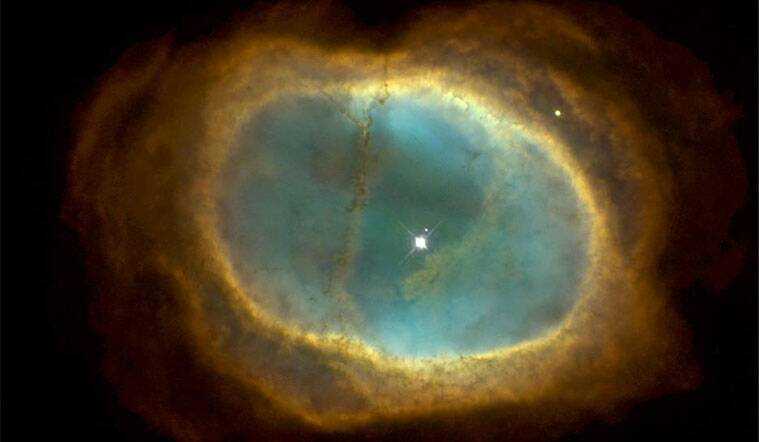NASA Webb Space telescope images Highlights: Cosmic cliffs and the blistering birthplace of stars
NASA has published some of the incredible and shocking images of the universe taken from its very powerful “James Webb Space Telescope”.
The National Aeronautics Space Administration popularly known as NASA on Tuesday released the images of the universe taken from the powerful “James Webb Space Telescope” along with the data of a distant planet’s atmosphere.
The first image published shows the galaxy cluster SMACS 0723 which is also known as Webb’s First Deep Field. The image is a complex made from different images taken at different wavelengths. It was made using the images taken with the NIRCam (Near-Infrared Camera).
NASA then published the images of the Carina Nebula, WASP-96 b (spectrum data), Southern Ring Nebula and Stephen’s Quintet.
The high-resolution versions of these images are now available on the website of NASA.
In the presence of water vapour on the distant exoplanet, the spectrum data of WASP-96B was revealed for the first time.
The image of the “Southern Ring Nebula” captured the “final performance” of a dying star.
The picture of “Stephan’s Quintet” cleared new light on the evolution of universes and black holes with the galaxies in a “galactic dance” or cosmic balances with each other.
NASA completed the Livestream with remarkable high-resolution images of a star-forming area in the Carina Nebula called NGC 3324.
The images revealed how “Mountains” and “Valleys” look like shining in the sunlight. But, were really features that were 7 light-years high.
The cradle of star appearance showed the relationship between dust and gas clouds and blisteringly hot young stars.

NASA and president of the US Joe Biden revealed the first image of the universe taken using the James Webb Space Telescope.
The first image revealed is of the galaxy cluster SMACS 0723. NASA calls it the deepest and sharpest infrared of the alien universe taken to date.
Carina Nebula

The above image shows the “Carina Nebula”, which is one of the very first targets of the “James Webb Space Telescope”
It is one of the largest and brightest nebulae in our sky and it is also the home to many massive stars, which are many times the size of the sun.
Nebulae are often referred to as “stellar nurseries” cause these clouds of gas and dust are where stars are formed or created.
Southern Ring Nebula

In this image, we can notice the Southern Ring Nebula, which acts as another one of Webb’s first marks.
It is also referred to as the “Eight-Burst” nebula because of its physique compares to the 8 number when we look at it via a telescope.
Because of its cloud of gas and dust surrounding a dying star, The Southern Ring Nebula is what is referred to as a planetary nebula.
From our planet, this Eight-Burst nebula is nearby 2,000 light-years away and it has a diameter of nearly half a light-year.
Stephen’s Quintet

A Webb Space telescope also be targeting a “Stephan’s Quinter” which is a set of five galaxies where four galaxies are locked in a “cosmic dance” of repeated close encounters.
The Stephen’s Quintet was one of the popular first compact galaxy groups ever located.
Quintet is about 290 million light-years away from us in the direction of “The Pegasus constellation”.
NASA announces the first image

NASA’s Goddard Space Centre revealed the first image taken from the Webb Space Telescope. It is the exact deep field image of SMACS 0723 published earlier.
Some of the cosmic objects in the image are captured as they were before 13.1 billion years. Webb Space Telescope took 4 days to create the image, likened to the ten days taken by Hubble for a lower-resolution image.
The Distant galaxies have been brought into sharp focus, letting us see tiny, faint structures that have never been seen before, including star groups and diffuse features by the telescope’s NIRCam.
While watching the youngest galaxies in the picture, we are looking back in time to within a billion years after the big bang.
Another brilliant feature is the
Another special feature is the main arcs in the field. The powerful gravitational fields of galaxy clusters bend light rays from distant galaxies after them, generating an effect known as gravitational lensing.
Stars have been caught with major diffraction spikes because they seem brighter at more temporary wavelengths.
The final performance of a dying star

This picture is a near-infrared image of the Southern Ring Nebula or the “Eight-burst Nebula,” a planetary nebula surrounding a dying star.
In the image, the stars at the centre are prominent. It also shows for the first time that the second dimmer star is surrounded by dust from Webb’s telescope NIRCam on the left while the image from Webb’s MIRI is on the right.
As the pair circles each other, they “stir the pot” of gas and dust, causing asymmetrical patterns. The brighter star is younger and will likely project its own planetary nebula in the future
Earlier, the widest shells of gas toward the outer areas of the image were rejected. Each surface of gas in the picture represents the time when the lighter star lost some of its mass.
By tracing all these ejections, scientists can look into the history of the system. The ones shell nearest to the star are the most recent.
Shedding light into galaxy evolutions and black holes

This image is an enormous mosaic of Stephan’s Quintet and the biggest picture taken by the Webb Space Telescope to date. It covers over 150 million pixels and is made from 1,000 separate image files.
The picture reveals the dramatic impact of massive shockwaves as one of the galaxies breaks through the cluster. It also shows a black hole in the Quintet in a detail never noticed before.
Only the four of the galaxies are actually close together and caught in a “cosmic dance”, even though they are called a quintet.
The leftmost galaxy is well in the foreground in comparison with the other four. It is approximately 40 million light-years away from the earth while the rest of the four are about 290 million light-years away. But even that distance is relatively close in cosmic terms.
Exploring such ‘nearby’ universes like helps scientists better understand the dynamics in a more distant galaxy. Such tightly-packed groups might have been more common in the early period of the universe when their hot material may have fueled highly active black holes called quasars.
Even as we witness the quintet today, the topmost galaxy holds an active supermassive black hole 24 million times the group of the Sun.
Cosmic cliffs and the blistering birthplace of stars

NASA revealed the last and final image that shows a star-forming area in the Carina Nebula called NGC 3324, and its “mountains” and “valleys” speckled with glittering stars.
Captured in infrared for the first time by the Webb Space telescope, the latest new image shows previously invisible areas of star birth.
The image corresponds to craggy mountains on a moonlit evening. Actually, it is the edge of the giant gaseous cavity within the region of the nebula and some of the highest “peaks” in the nebula are around 7 light-years high.
The huge area in the picture was cut from the nebula by the extreme ultraviolet radiation and stellar winds from extremely hot young stars found in the centre of this “bubble,” above the area shown in the image.
This young star’s extreme ultraviolet radiation is slowly rotting it away. Some pillars tower about the bright wall of gas, resisting the star’s radiation. What looks like steam rising from the “mountains” is hot ionised gas and hot dust flowing away from the nebula because of radiation.



